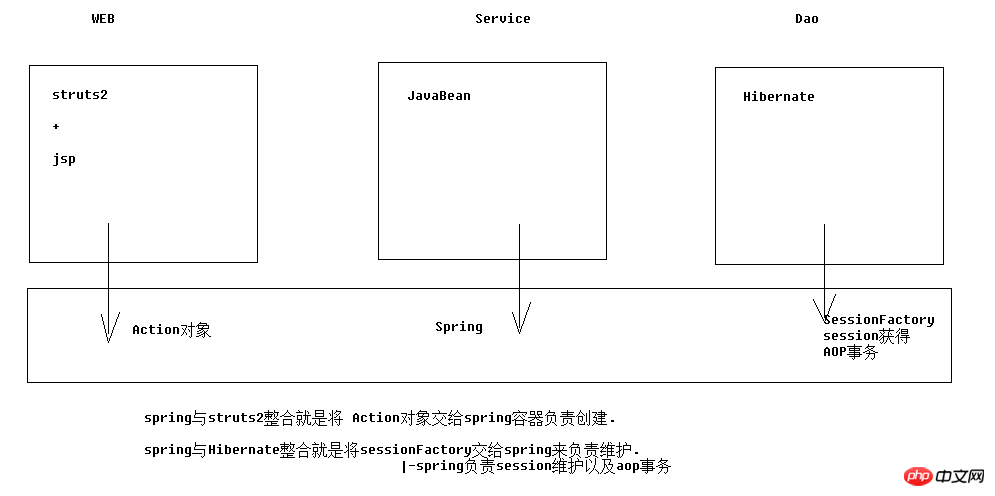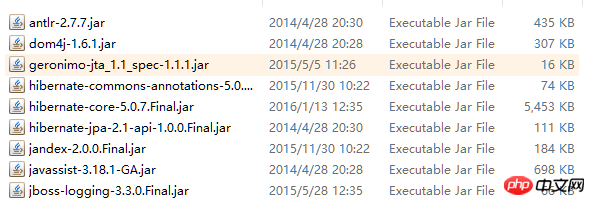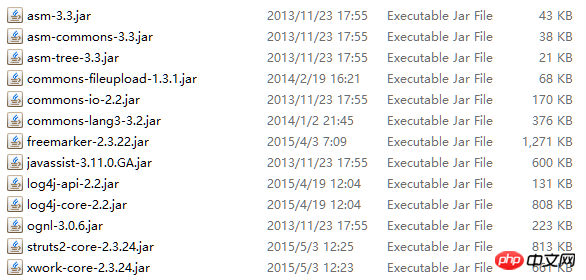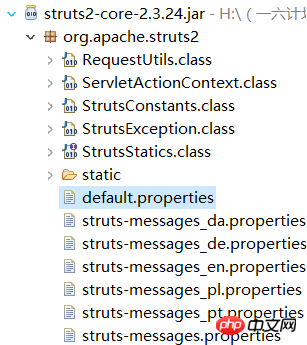
SSH fait référence au framework classique de javaweb. On ne peut pas dire que 100% des gens ont besoin de connaître le framework SSH, mais la plupart des entreprises l'utilisent. Lorsqu'il s'agit de frameworks, elles mentionneront ssh. la fois, j'en utiliserai un très simple. Enregistrez un exemple pour intégrer le framework SSH. Lors de l'intégration de frameworks, vous devez veiller à tester chaque framework séparément avant l'intégration, sinon il sera difficile de résoudre les problèmes après l'intégration.
Environnement : windows + MyEclipse + JDK1.7 + Tomcat7 + MySQL
Le code a été testé s'il y a une erreur, c'est peut-être parce que je ne l'ai pas décrit clairement à certains endroits.




Remarque : Duplication entre le package javassist-3.18.1-GA.jar et hibernate (ne conserver que la version supérieure)

Remarque : une fois ce package importé, struts2 recherchera le conteneur spring au démarrage. S'il n'est pas trouvé, une exception sera levée


<?xml version="1.0" encoding="UTF-8"?><beans xmlns:xsi="http://www.w3.org/2001/XMLSchema-instance"xmlns="http://www.springframework.org/schema/beans"
xmlns:context="http://www.springframework.org/schema/context"xmlns:aop="http://www.springframework.org/schema/aop"
xmlns:tx="http://www.springframework.org/schema/tx"xsi:schemaLocation="http://www.springframework.org/schema/beans
http://www.springframework.org/schema/context/spring-context-4.2.xsd
http://www.springframework.org/schema/aop/spring-aop-4.2.xsd
http://www.springframework.org/schema/tx/spring-tx-4.2.xsd "><bean name="userAction" class="cn.xyp.web.action.UserAction"></bean></beans><!-- 让spring随web启动而创建的监听器 --> <listener> <listener-class>org.springframework.web.context.ContextLoaderListener</listener-class> </listener> <!-- 配置spring配置文件位置参数 --> <context-param> <param-name>contextConfigLocation</param-name> <param-value>classpath:applicationContext.xml</param-value> </context-param>
<?xml version="1.0" encoding="UTF-8"?>
<!DOCTYPE struts PUBLIC
"-//Apache Software Foundation//DTD Struts Configuration 2.3//EN"
"http://struts.apache.org/dtds/struts-2.3.dtd"><struts><package name="crm" namespace="/" extends="struts-default"><action name="UserAction_*" class="cn.xyp.web.action.UserAction" method="{1}"><result name="success">/success.jsp</result></action></package></struts><!-- struts2核心过滤器 --> <filter> <filter-name>struts2</filter-name> <filter-class>org.apache.struts2.dispatcher.ng.filter.StrutsPrepareAndExecuteFilter</filter-class> </filter> <filter-mapping> <filter-name>struts2</filter-name> <url-pattern>/*</url-pattern> </filter-mapping>

### if specified, the default object factory can be overridden here ### Note: short-hand notation is supported in some cases, such as "spring" ### Alternatively, you can provide a com.opensymphony.xwork2.ObjectFactory subclass name here # struts.objectFactory = spring ### specifies the autoWiring logic when using the SpringObjectFactory. ### valid values are: name, type, auto, and constructor (name is the default) struts.objectFactory.spring.autoWire = name
<!-- # struts.objectFactory = spring 将action的创建交给spring容器
struts.objectFactory.spring.autoWire = name spring负责装配Action依赖属性--><constant name="struts.objectFactory" value="spring"></constant> <!-- 整合方案1:class属性上仍然配置action的完整类名
struts2仍然创建action,由spring负责组装Action中的依赖属性 --><action name="UserAction_*" class="cn.xyp.web.action.UserAction" method="{1}" ><result name="toHome" type="redirect" >/index.htm</result><result name="error" >/login.jsp</result></action>4. Solution d'intégration 2 : spring est responsable de la création de l'action et de l'assemblage (Recommandé)
<!-- action --><!-- 注意:Action对象作用范围一定是多例的.这样才符合struts2架构 --><bean name="userAction" class="cn.itcast.web.action.UserAction" scope="prototype" ><property name="userService" ref="userService" ></property></bean>
<!--
整合方案2:class属性上填写spring中action对象的BeanName
完全由spring管理action生命周期,包括Action的创建
注意:需要手动组装依赖属性 --><action name="UserAction_*" class="userAction" method="{1}" ><result name="toHome" type="redirect" >/index.htm</result><result name="error" >/login.jsp</result></action>6. Configurer la mise en veille prolongée séparément
1. Importer les classes d'entités et les métadonnées d'orm Exemple : User.java
package cn.xyp.web.domain;import java.util.HashSet;import java.util.Set;public class User {private Long user_id;private String user_code;private String user_name;private String user_password;private Character user_state;public Long getUser_id() {return user_id;
}public void setUser_id(Long user_id) {this.user_id = user_id;
}public String getUser_code() {return user_code;
}public void setUser_code(String user_code) {this.user_code = user_code;
}public String getUser_name() {return user_name;
}public void setUser_name(String user_name) {this.user_name = user_name;
}public String getUser_password() {return user_password;
}public void setUser_password(String user_password) {this.user_password = user_password;
}public Character getUser_state() {return user_state;
}public void setUser_state(Character user_state) {this.user_state = user_state;
}
@Overridepublic String toString() {return "User [user_id=" + user_id + ", user_code=" + user_code + ", user_name=" + user_name + ", user_password="
+ user_password + "]";
}
}<?xml version="1.0" encoding="UTF-8"?><!DOCTYPE hibernate-mapping PUBLIC
"-//Hibernate/Hibernate Mapping DTD 3.0//EN"
"http://www.hibernate.org/dtd/hibernate-mapping-3.0.dtd"><hibernate-mapping package="cn.xyp.domain" ><class name="User" table="sys_user" ><id name="user_id" ><generator class="native"></generator></id><property name="user_code" ></property><property name="user_name" ></property><property name="user_password" ></property><property name="user_state" ></property></class></hibernate-mapping>
将sessionFactory对象交给spring容器管理
<!-- 加载配置方案1:仍然使用外部的hibernate.cfg.xml配置信息 --><bean name="sessionFactory" class="org.springframework.orm.hibernate5.LocalSessionFactoryBean" ><property name="configLocation" value="classpath:hibernate.cfg.xml" ></property></bean>
<!-- 加载配置方案2:在spring配置中放置hibernate配置信息 --><bean name="sessionFactory" class="org.springframework.orm.hibernate5.LocalSessionFactoryBean" ><!-- 将连接池注入到sessionFactory, hibernate会通过连接池获得连接 --><property name="dataSource" ref="dataSource" ></property><!-- 配置hibernate基本信息 --><property name="hibernateProperties"><props><!-- 必选配置 --><prop key="hibernate.connection.driver_class" >com.mysql.jdbc.Driver</prop><prop key="hibernate.connection.url" >jdbc:mysql:///crm_32</prop><prop key="hibernate.connection.username" >root</prop><prop key="hibernate.connection.password" >1234</prop> <prop key="hibernate.dialect" >org.hibernate.dialect.MySQLDialect</prop><!-- 可选配置 --><prop key="hibernate.show_sql" >true</prop><prop key="hibernate.format_sql" >true</prop><prop key="hibernate.hbm2ddl.auto" >update</prop></props></property><!-- 引入orm元数据,指定orm元数据所在的包路径,spring会自动读取包中的所有配置 --><property name="mappingDirectoryLocations" value="classpath:cn/itcast/domain" ></property></bean>
jdbc.jdbcUrl=jdbc:mysql:///xyp_crm jdbc.driverClass=com.mysql.jdbc.Driver jdbc.user=root jdbc.password=123456
<!-- 读取db.properties文件 --><context:property-placeholder location="classpath:db.properties" /><!-- 配置c3p0连接池 --><bean name="dataSource" class="com.mchange.v2.c3p0.ComboPooledDataSource" ><property name="jdbcUrl" value="${jdbc.jdbcUrl}" ></property><property name="driverClass" value="${jdbc.driverClass}" ></property><property name="user" value="${jdbc.user}" ></property><property name="password" value="${jdbc.password}" ></property></bean><bean name="sessionFactory" class="org.springframework.orm.hibernate5.LocalSessionFactoryBean" ><!-- 将连接池注入到sessionFactory, hibernate会通过连接池获得连接 --><property name="dataSource" ref="dataSource" ></property>
注意:项目中要确保使用统一版本。

//HibernateDaoSupport 为dao注入sessionFactorypublic class UserDaoImpl extends HibernateDaoSupport implements UserDao { @Overridepublic User getByUserCode(final String usercode) {//HQLreturn getHibernateTemplate().execute(new HibernateCallback<User>() {
@Overridepublic User doInHibernate(Session session) throws HibernateException {
String hql = "from User where user_code = ? ";
Query query = session.createQuery(hql);
query.setParameter(0, usercode);
User user = (User) query.uniqueResult();return user;
}
}); //CriteriaDetachedCriteria dc = DetachedCriteria.forClass(User.class);
dc.add(Restrictions.eq("user_code", usercode));
List<User> list = (List<User>) getHibernateTemplate().findByCriteria(dc); if(list != null && list.size()>0){return list.get(0);
}else{return null;
}<!-- Dao --><bean name="userDao" class="cn.xyp.dao.impl.UserDaoImpl" ><!-- 注入sessionFactory --><property name="sessionFactory" ref="sessionFactory"></property></bean>
<!-- 核心事务管理器 --><bean name="transactionManager" class="org.springframework.orm.hibernate5.HibernateTransactionManager" ><property name="sessionFactory" ref="sessionFactory" ></property></bean>
<!-- 配置通知 --><tx:advice id="txAdvice" transaction-manager="transactionManager" > <tx:attributes><tx:method name="save*" isolation="REPEATABLE_READ" propagation="REQUIRED" read-only="false" /> <tx:method name="persist*" isolation="REPEATABLE_READ" propagation="REQUIRED" read-only="false" /> <tx:method name="update*" isolation="REPEATABLE_READ" propagation="REQUIRED" read-only="false" /> <tx:method name="modify*" isolation="REPEATABLE_READ" propagation="REQUIRED" read-only="false" /> <tx:method name="delete*" isolation="REPEATABLE_READ" propagation="REQUIRED" read-only="false" /> <tx:method name="remove*" isolation="REPEATABLE_READ" propagation="REQUIRED" read-only="false" /> <tx:method name="get*" isolation="REPEATABLE_READ" propagation="REQUIRED" read-only="true" /> <tx:method name="find*" isolation="REPEATABLE_READ" propagation="REQUIRED" read-only="true" /> </tx:attributes> </tx:advice>
<!-- 配置将通知织入目标对象
配置切点
配置切面 --><aop:config>
<aop:pointcut expression="execution(* cn.itcast.service.impl.*ServiceImpl.*(..))" id="txPc"/>
<aop:advisor advice-ref="txAdvice" pointcut-ref="txPc" />
</aop:config><!-- 开启注解事务 --><tx:annotation-driven transaction-manager="transactionManager" />
@Transactional(isolation=Isolation.REPEATABLE_READ,propagation=Propagation.REQUIRED,readOnly=true)public class UserServiceImpl implements UserService{ @Override
@Transactional(isolation=Isolation.REPEATABLE_READ,propagation=Propagation.REQUIRED,readOnly=false)public void saveUser(User u) {
ud.save(u);
}
为了避免使用懒加载时出现no-session问题.需要扩大session的作用范围。
<!-- 扩大session作用范围
注意: 任何filter一定要在struts的filter之前调用
因为struts是不会放行的 -->
<filter> <filter-name>openSessionInView</filter-name> <filter-class>org.springframework.orm.hibernate5.support.OpenSessionInViewFilter</filter-class>
</filter>
<filter-mapping> <filter-name>openSessionInView</filter-name> <url-pattern>/*</url-pattern>
</filter-mapping>
<struts><!-- # struts.objectFactory = spring 将action的创建交给spring容器
struts.objectFactory.spring.autoWire = name spring负责装配Action依赖属性--><constant name="struts.objectFactory" value="spring"></constant><package name="crm" namespace="/" extends="struts-default" ><global-exception-mappings><exception-mapping result="error" exception="java.lang.RuntimeException"></exception-mapping></global-exception-mappings> <!--
整合方案:class属性上填写spring中action对象的BeanName
完全由spring管理action生命周期,包括Action的创建
注意:需要手动组装依赖属性 --><action name="UserAction_*" class="userAction" method="{1}" ><result name="toHome" type="redirect" >/index.htm</result><result name="error" >/login.jsp</result></action></package></struts>public class UserAction extends ActionSupport implements ModelDriven<User> {private User user = new User(); private UserService userService ; public void setUserService(UserService userService) {this.userService = userService;
}
public String login() throws Exception {
//
1 调用Service执行登陆逻辑User u = userService.getUserByCodePassword(user);
//
2 将返回的User对象放入session域ActionContext.getContext().getSession().put("user", u);//
3 重定向到项目首页return "toHome";
}
@Overridepublic User getModel() {return user;
}
} public User getUserByCodePassword(User u) {
// 1 根据登陆名称查询登陆用户User existU = ud.getByUserCode(u.getUser_code());// 2 判断用户是否存在.不存在=>抛出异常,提示用户名不存在if (existU == null) {throw new RuntimeException("用户名不存在!");
}
// 3 判断用户密码是否正确=>不正确=>抛出异常,提示密码错误if (!existU.getUser_password().equals(u.getUser_password())) {throw new RuntimeException("密码错误!");
}
// 4 返回查询到的用户对象return existU;
} public User getByUserCode(final String usercode) {
//CriteriaDetachedCriteria dc = DetachedCriteria.forClass(User.class);
dc.add(Restrictions.eq("user_code", usercode));
List<User> list = (List<User>) getHibernateTemplate().findByCriteria(dc); if(list != null && list.size()>0){return list.get(0);
}else{return null;
}
}Ce qui précède est le contenu détaillé de. pour plus d'informations, suivez d'autres articles connexes sur le site Web de PHP en chinois!